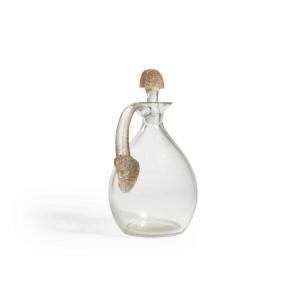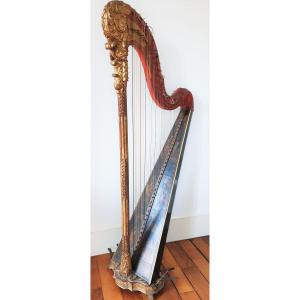Visual Characteristics: Table View: Shape: The mandolin has a characteristic teardrop shape. Soundboard: Made up of two inclined parts, in wood, inlaid to improve sound projection. Rosette: The soundhole around the sound opening is decorated, probably with the manufacturer's inscription (Gelas). Bridge: Specific with a leather protection plate under the bridge to prevent scratches from the pick. Neck: Ebony with white dot inlays to mark the frets. Headstock: The headstock is slotted and has two rows of tuning keys. Back View: Back: In figured wood, offering an elegant and distinctive aesthetic. Neck: Extends in a gentle curve toward the headstock, maintaining the aesthetic harmony of the instrument. Tuning Keys: In-line, making precise tuning easy. Side View: Depth: Shows the depth of the mandolin body, contributing to sound resonance. Construction: Visible, the care given to details and the quality of the wood used. Brand Detail: Stamping: The mandolin is stamped with the serial number (5947) and the date (1927), attesting to its authenticity. Marquetry: Inlaid details add aesthetic and historical value to the instrument. Specific Information: Serial Number: 5947 Date of Manufacture: 1927 Stamping: Visible on the soundboard. History of the Gelas Mandolin The Beginnings of the Mandolin: Origins: The mandolin appeared in Italy in the 16th century as an evolution of the mandora, and quickly gained popularity in Europe. Evolution: The Neapolitan mandolin became the standard in the 18th century with its four pairs of metal strings. The Innovation of Jean-Baptiste Gelas: Context: At the beginning of the 20th century, Jean-Baptiste Gelas, a French luthier born in 1855, revolutionized the design of the mandolin. Design: He invented the double-top mandolin, improving projection and clarity of sound with an angled soundboard. Patent: Gelas filed several patents for his innovations in the 1920s. The Gelas Mandolin: Sound: The Gelas design allows for better resonance and a more powerful sound volume, making it popular among musicians. Use: Used in various musical genres, from classical to folk music. Biography of Jean-Baptiste Gelas Youth and Training: Birth: Jean-Baptiste Gelas was born in 1855 in France. Training: Trained as a luthier, he developed a particular interest in plucked string instruments. Career: Innovations: In the 1920s, he introduced the double-top mandolin and continued to improve his designs throughout his career. Patent and Recognition: Files several patents for its innovations and its instruments are recognized for their exceptional quality. Legacy: Impact: His legacy endures through his landmark innovations in mandolin manufacturing. His instruments are sought after by collectors and musicians around the world. Death: Jean-Baptiste Gelas died in 1938, leaving an indelible mark in the history of violin making. The Gelas mandolin, numbered and dated, is a remarkable example of Gelas artisanal excellence, combining technical innovation and elegant aesthetics.









































 Le Magazine de PROANTIC
Le Magazine de PROANTIC TRÉSORS Magazine
TRÉSORS Magazine Rivista Artiquariato
Rivista Artiquariato